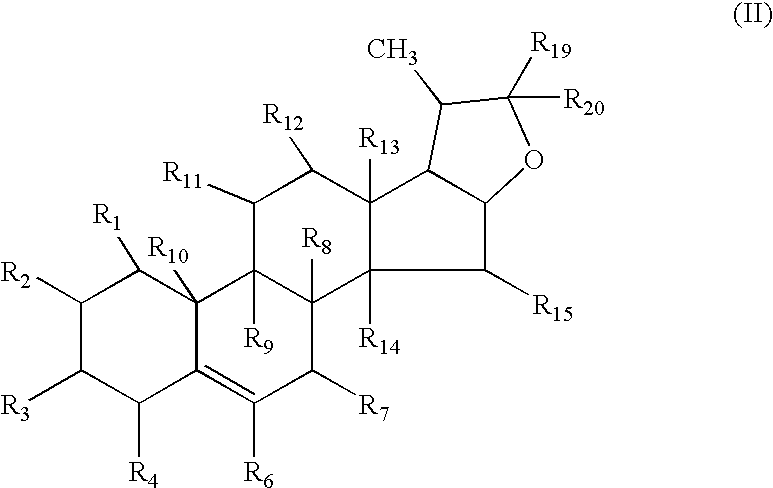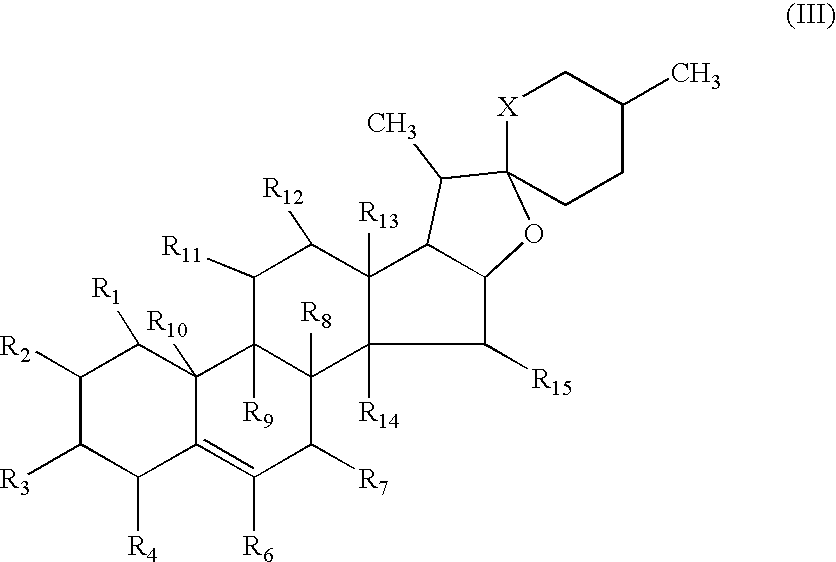Neuroprotective spirostenol pharmaceutical compositions
a technology of spirostenol and composition, applied in the direction of pharmaceutical active ingredients, medical preparations, organic active ingredients, etc., can solve the problems of cognitive function decline, loss of short-term memory, and brain death of nerve cells,
- Summary
- Abstract
- Description
- Claims
- Application Information
AI Technical Summary
Benefits of technology
Problems solved by technology
Method used
Image
Examples
example i
Tissue Samples
[0191] All human tissue samples were obtained from the Harvard Brain Tissue Resource Center (Belmont, Mass.). Samples for steroid measurements were either snap frozen or passively frozen in liquid nitrogen. Brain hippocampus and frontal cortex samples were obtained from 19 patients, 12 AD (6 men and 6 women) and 7 age-matched control patients (4 men and 3 women). AD patients were classified by the Harvard Tissue Resource Center as having “severe AD.” Mean age for all patients was 74.6±7.2 years for AD patients and 73.4±10.5 years for control. Mean post-mortem interval was 10.2 hours for AD patients and 14.7 hours for control. Protocols for the use of human tissue were approved by the Georgetown University Internal Review Board.
Purification and Measurement of 22R-hydroxycholesterol
[0192] Samples were extracted and purified by reverse phase HPLC as previously described. Brown et al., J. Neurochem. 74, 847-859 (2000). Fractions containing 22R-hydroxycholesterol were ...
example ii
Materials
[0213] Aβ1-42 peptide was purchased from American Peptide Co. (Sunnyvale, Calif.). 22R-hydroxycholesterol (SP222) was purchased from Sigma (St Louis, Mo.). [22-3H]R-hydroxycholesterol (sp. act. 20 Ci / mmol) was synthesized by American Radiolabeled Chemical (St Louis, Mo.). The 22R-hydroxycholesterol derivatives (SP223-238) were purchased from Interbioscreen (Moscow, Russia). Cells culture supplies were purchased form GIBCO (Grand Island, N.Y.) and cell culture plasticware was from Corning (Corning, N.Y.) and Packard BioSciences Co. (Meriden, Conn.).
In Silico Screening for 22R-hydroxycholesterol Derivatives
[0214] The Interbioscreen Database of naturally occurring entities was screened for compounds containing the 22R-hydroxycholesterol structure using the ISIS software (Information Systems, Inc., San Leandro, Calif.). The structure of the selected and tested 22R-hydroxycholesterol (SP222) and derivatives (SP223-238) are shown in FIG. 1 and the denomination, chemical name...
example iii
Materials and Methods
Immunoblot Analysis of Aβ Polymerization and Amyloid Derived Diffusible Ligand (ADDL) Formation
[0241] Increasing concentration of Aβ (0.1, 1 and 10 μM) were incubated in PC12 culture medium for 24 hours and 72 hours at 37° C. under 5% CO2 with or without increasing concentrations of SP233 (1, 10 and 100 μM). At the end of the incubation time, samples were separated by 4-20% Tris-Glycine gel electrophoresis (Invitrogen) under native conditions at 125V for 2 hours and transferred to nitrocellulose membrane (Hybond™ ECL™, Amersham Pharmacia Biotech) at 130A for 30 minutes. Non-specific adsorption of the antibodies was blocked by incubating the nitrocellulose in 5% milk. The blots were treated for immunodetection of Aβ species using a polyclonal antibody to Aβ that recognizes a 30 amino acid peptide of the Aβ protein (Zymed Laboratories, San Francisco, Calif.). Membranes were incubated in primary antibody for 1 hour at room temperature at a dilution of 1:2,000. ...
PUM
 Login to View More
Login to View More Abstract
Description
Claims
Application Information
 Login to View More
Login to View More - R&D
- Intellectual Property
- Life Sciences
- Materials
- Tech Scout
- Unparalleled Data Quality
- Higher Quality Content
- 60% Fewer Hallucinations
Browse by: Latest US Patents, China's latest patents, Technical Efficacy Thesaurus, Application Domain, Technology Topic, Popular Technical Reports.
© 2025 PatSnap. All rights reserved.Legal|Privacy policy|Modern Slavery Act Transparency Statement|Sitemap|About US| Contact US: help@patsnap.com



